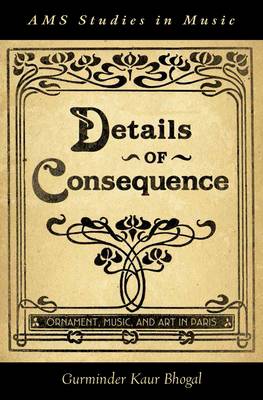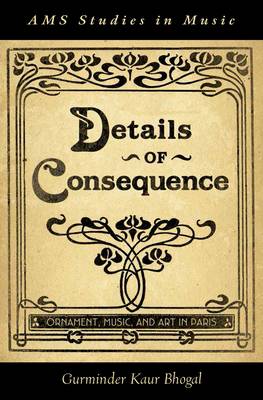
Je cadeautjes zeker op tijd in huis hebben voor de feestdagen? Kom langs in onze winkels en vind het perfecte geschenk!
- Afhalen na 1 uur in een winkel met voorraad
- Gratis thuislevering in België vanaf € 30
- Ruim aanbod met 7 miljoen producten
Je cadeautjes zeker op tijd in huis hebben voor de feestdagen? Kom langs in onze winkels en vind het perfecte geschenk!
- Afhalen na 1 uur in een winkel met voorraad
- Gratis thuislevering in België vanaf € 30
- Ruim aanbod met 7 miljoen producten
Zoeken
€ 193,45
+ 386 punten
Omschrijving
Details of Consequence examines a trait that is taken for granted and rarely investigated in fin-de-siècle French music: ornamental extravagance. Considering why such composers as Claude Debussy, Maurice Ravel, Gabriel Fauré, Igor Stravinsky, and Erik Satie, turned their attention to the seemingly innocuous and allegedly superficial phenomenon of ornament at pivotal moments of their careers, this book shows that the range of decorative languages and unusual ways in which ornament is manifest in their works doesn't only suggest a willingness to decorate or render music beautiful. Rather, in keeping with the sorts of changes that decorative expression was undergoing in the work of Eugène Grasset, Pierre Bonnard, Henri Matisse, and other painters, composers also invested their creative energies in re-imagining ornament, relying on a variety of decorative techniques to emphasize what was new and unprecedented in their treatment of form, meter, rhythm, melody, and texture. Furthermore, abundant displays of ornament in their music served to privilege associations that had been previously condemned in Western philosophy such as femininity, sensuality, exoticism, mystery, and fantasy. Alongside specific visual examples, author Gurminder Kaur Bhogal offers analyses of piano pieces, orchestral music, chamber works, and compositions written for the Ballets Russes to highlight the disorienting effect of musical experiments with ornament. Acknowledging the willingness of listeners to borrow vocabulary from the visual arts when describing decorative music, Bhogal probes the formation of art-music metaphors, and studies the cognitive impetus behind tendencies to posit stylistic parallels. She further illustrates that the rising expressive status of ornament in music and art had broad social and cultural implications as evidenced by its widespread involvement in debates on French identity, style, aesthetics, and progress. Drawing on a range of recent scholarship in the humanities at large, including studies in feminist theory, nationalism, and orientalism, Details of Consequence is an intensely interdisciplinary look at an important facet of fin-de-siècle French music.
Specificaties
Betrokkenen
- Auteur(s):
- Uitgeverij:
Inhoud
- Aantal bladzijden:
- 368
- Taal:
- Engels
- Reeks:
Eigenschappen
- Productcode (EAN):
- 9780199795055
- Verschijningsdatum:
- 9/10/2013
- Uitvoering:
- Hardcover
- Formaat:
- Genaaid
- Afmetingen:
- 160 mm x 236 mm
- Gewicht:
- 657 g

Alleen bij Standaard Boekhandel
+ 386 punten op je klantenkaart van Standaard Boekhandel
Beoordelingen
We publiceren alleen reviews die voldoen aan de voorwaarden voor reviews. Bekijk onze voorwaarden voor reviews.









